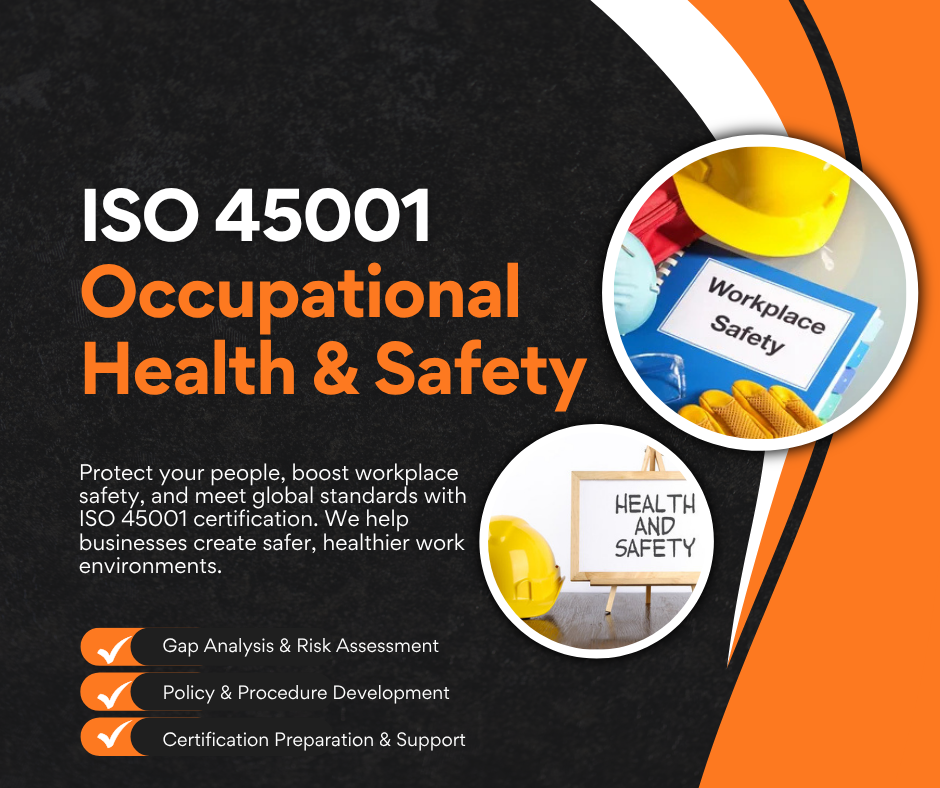Occupational Health and Safety Management System
Empowering Safer Workplaces with ISO 45001:2018 – Your Safety, Our Priority!

ISO 45001:2018 is an international standard that defines the requirements for an OHSMS. Its goal is to prevent work-related harm and support the physical and mental health of employees. The standard follows the Plan–Do–Check–Act (PDCA) cycle and uses a risk-based approach. Any type of organization can apply it, from small workshops to large industries. Published by the International Organization for Standardization (ISO), it replaces older national systems and provides a single global model for safety management. Purpose of a Health and Safety Management System An OHSMS helps an organization: find hazards and evaluate the risks; decide what legal and other requirements apply; set clear objectives for improvement; assign duties and provide resources; monitor results and correct weaknesses. It links planning, operation, checking, and improvement so that safe work practices continue each day.
Hazards are identified early and managed before harm occurs.
Processes follow current occupational-safety laws.
The safety policy is the responsibility of top management.
Workers assist in identifying issues and then providing corrective action.
Throughout the entire planning process, risks and opportunities are taken into account.
Emergency protocols prevent confusion and damage.
Less disruption and downtime result from fewer issues.
Cooperation and morale are enhanced in safe environments.
Includes fewer injuries, less compensation, and cheaper medical bills.
Reviews and audits maintain the system's efficacy.
Inspection logs, safety maintenance, and machine guarding.
Site supervision, lifting plans, and fall protection.
Safe medical waste management and infection prevention.
Emergency planning, driver fitness, and vehicle inspections.
Hygiene, ergonomic design, and equipment safety.
Laboratory rules and fire-drill practice.
Permit-to-work and confined-space procedures.
Travel safety and client-site risk assessment.
Lock-out mechanisms and electrical safety.
Monthly safety meetings and basic checklists.
Daily duties are made more predictable and orderly by the system. Everyone is aware of how to report issues and how to carry out each task safely. Evidence of control can be found in training, inspection, and incident records. Audits reveal problems early, and corrective actions stop recurrence. Management decisions are based on facts, not assumptions. Regular meetings keep awareness high and promote cooperation between departments. Stable, safe operations lead to better quality and less waste. When new staff join, orientation and clear instructions help them work safely from the start. Over time, safety becomes part of the organization’s normal behavior and shared culture.
A: No. Certification is voluntary, but many clients and regulators expect it.
A: Yes. The standard is flexible and can be scaled to any size or type of work.
A: Only the information required to control processes and show conformity.
A: Internal audits occur at planned times; certification audits are usually once a year.
A: Leading by example, evaluating performance, and encouraging improvement are all necessary for top management.
An organized approach to managing occupational health and safety is offered by ISO 45001:2018. It helps meet legal obligations, reduce incidents, and improve worker well-being. When properly applied, it strengthens trust among employees, customers, and regulators. A Health and Safety Management System is more than a set of forms. It is a way of managing work so that people return home safe each day. Through planning, action, checking, and improvement, safety becomes part of business success. Implementing ISO 45001:2018 allows any organization to control risk, meet objectives, and maintain a healthy, safe, and productive workplace.
Quality Management System :
Unlock Quality Excellence with ISO 9001:2015“ Your Path to Superior Management!
Environmental Management System :
Build a Greener Tomorrow with ISO 14001:2015“ Your Guide to
Sustainable Success!
Information Security Management System (ISMS)
Secure Your Information, Secure Your Future with ISO 27001:2022!
Get in touch with our expert consultants to begin your journey to compliance and operational excellence.
Request Consultation